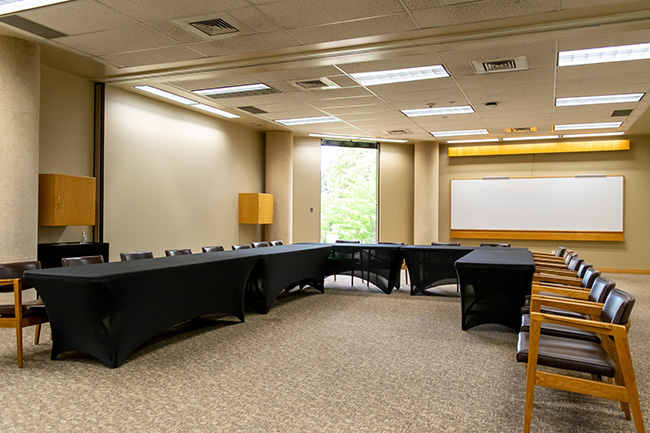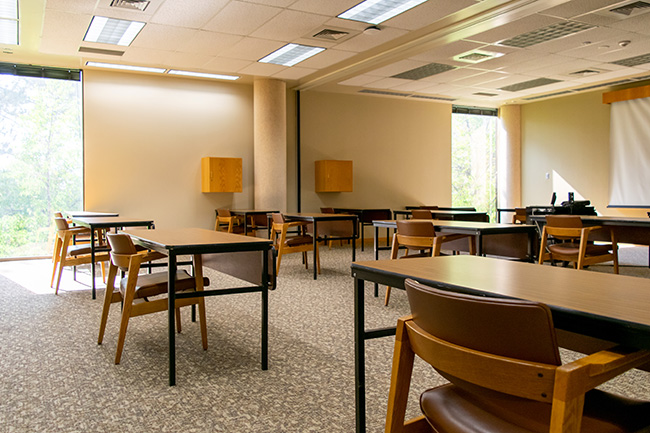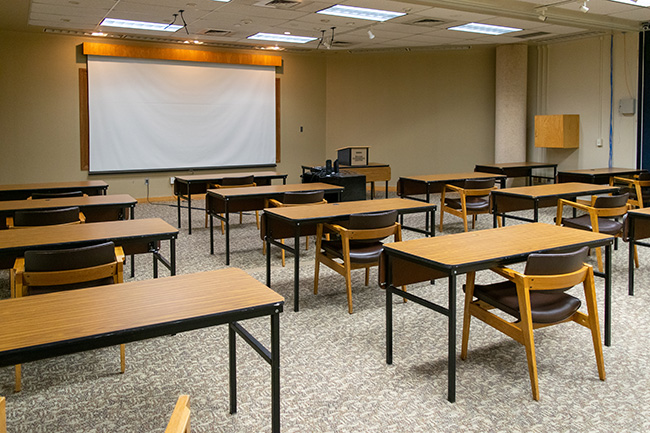Eccles Conference Center
This building is dedicated to the memory of David and Ellen Stoddard Eccles. The vision, energy and astute management of David Eccles contributed significantly to the industrial growth of the intermountain and northwest areas of America. Ellen Stoddard Eccles was a devoted wife and mother under whose affectionate guidance nine children were raised.
The couple’s children, Marriner, Marie, Spencer, Jessie, Emma, George, Nora, Ellen and Willard, true to the legacy of achievement inherited from their parents, have given service to Utah and nation with their leadership, industry and notable accomplishments.
Utah State University has been the recipient of the Eccles family’s generous philanthropic spirit, a spirit that has encompassed the entire range of university programs and, to a substantial degree, made this building possible. The rewards of the educational endeavors, which this building will foster, will ripple outward in ever-widening circles, touching and molding the lives of generations to come.
Emma Eccles Jones Conference Room (1898-1991)
Rooms 201 and 203

Emma Eccles Jones was born to David and Ellen Stoddard Eccles. The Eccles family moved to Logan when Emma was a child. She attended Utah State Agricultural College (now Utah State University), Radcliffe College and Harvard University and received a degree in English from the University of California-Berkeley. She established the first kindergarten program in Logan in cooperation with another Utah education pioneer, Edith Bowen.
Emma received a doctorate in humanities from USU in 1985. She was a patron of the arts and significant contributor to opera, symphony and ballet in California and Utah. The Emma Eccles Jones Foundation is a generous source of philanthropy in Utah.
S.J. (1893-1983) and Jessie Eccles (1896-1982) Quinney Conference Room
Rooms 205 and 207

Seymour Joseph and Jessie Eccles Quinney left as true legacies, their beliefs and philosophies of life. They gave unselfishly to their alma mater, Utah State University, where S.J. graduated in 1916 and Jessie in 1917.
Jessie was born on May 13, 1896, in Baker City, Oregon, the daughter of David and Ellen Stoddard Eccles. The family moved to Logan soon after Jessie’s birth.
S.J. was born on May 12, 1893, in Logan to bookkeeper Joseph Quinney and his wife Ida Theurer Quinney. He attended public schools in Logan. After graduating, S.J. enrolled at Harvard Law School. After his first year, he returned to Logan and married Jessie on August 17, 1917. They immediately returned to Boston, and she enrolled in Radcliffe.
Marriner S. Eccles Board Room (1890-1977)
Room 208

Marriner Eccles was born 9 September 1890, to David Eccles and his second wife, Ellen Stoddard, and was the oldest of nine children. Marriner attended Brigham Young College in Logan, Utah, which functioned more as a high school than a college. He left school in June 1909 at the age of 18. His father, whose schooling was limited, did not believe an extended education was necessary for success in business, and Marriner proved him correct. As the oldest son in his family, the responsibility for the welfare of his family, as well as the administration of their father’s estate, was thrust upon him.
Marriner first became president of the Hyrum State Bank, and a director and officer of the Thatcher Brothers Bank in Logan. In 1916, he organized the Eccles Investment Company, a holding company, to manage the inheritance left to them. Throughout the 1920s he built his business base in Utah. He assumed control of the First National Bank and First Savings Bank of Ogden. During the next decade Marriner acquired interests in additional banks, leading to the formation of the First Security Corporation in 1928, believed to have been the nation’s first bank holding company.
By 1930, the nation was in the grip of the Great Depression, and Marriner stood to lose much of what he had worked for during the previous eighteen years. His ideas about the need for government intervention in the economy and deficit financing directly contradicted that of others. However, because of Marriner’s testimony and subsequent meetings with men close to former U.S. President Franklin D. Roosevelt, he was asked to join the administration as an assistant to secretary of the treasury. In November of that year he was nominated by Roosevelt to head the Federal Reserve System. In 1936, Marriner was appointed as chairman of the board. In 1948, because he disagreed with President Harry S. Truman’s economic policies, Truman did not reappoint him as chairman. Marriner, however, was still a governor of the board.
Tupperware Room
Rooms 303 and 305

For more than 70 years, Tupperware has been committed to making a positive impact on the world. Through products, the company focuses on helping people reduce their individual impact on the environment through the use of reusable, durable and easy-to-use solutions that minimize plastic and food waste.
It started with a paint can. Chemist Earl Tupper had a spark of inspiration while creating molds at a plastics factory shortly after the Great Depression. If he could design an airtight seal for plastic storage containers, like those on a paint can, he could help war-weary families save money on costly food waste.
From revolutionizing microwave cooking that helps time-starved families get healthy meals on the table faster and easier, to growing vegetables in space with NASA, everything Tupperware does is driven by the desire to help save time, money, space, food and energy.
Today, Tupperware continues to innovate for the benefit of people and the planet. A leading global marketer of innovative, premium products across multiple brands, Tupperware Brands Corporation utilizes a relationship-based selling method through an independent sales force of 3 million around the world.
W. Adrian (1908-1996) and Edna (1910-2002) Wright Room
Room 313

Wallace Adrian Wright was born in Smithfield, Utah to Wallace Bruce and Emma Moser Wright, the second child of eleven. He grew up on a farm in Blackfoot, Idaho and graduated in business administration from Utah State Agricultural College, where he belonged to the business fraternity Alpha Kappa Psi and was editor of the yearbook. Throughout his career, Adrian worked for J. C. Penney Co.; and the U.S. Government with WPA and OPA. He also worked as a real estate agent and broker with Main Realty; and was broker and partner with Wright-Wirthlin Realty until he formed a family real estate business, W. Adrian Wright Realtors. Adrian was actively involved with the real estate profession, where he served as president of the Salt Lake Board of Realtors; as director of the Utah Association of Realtors; was a recipient of the Presidents’ Award of Salt Lake Board of Realtors; was a member of the Salt Lake Chamber of Commerce; and was a recipient of the Realtor of the Year award. Adrian is also credited as co-founder and director of Beehive State Bank; director of Commercial Security Bank; and director of Key Bank. He also served as president of the Utah State Retirement Board, was a co-developer of Deseret Inn Motel and served on the National Advisory Council at USU.
Edna was born in Logan, Utah to William McNeil Smith and Rachel Eliza Edwards Smith. Edna was the youngest of nine children. Edna graduated in 1932 from Utah State Agricultural College (now Utah State University). During her time at USU, she belonged to Alpha Sigma Nu (honorary senior fraternity); the Associated Women’s Student Council, Sorosis (later named Alpha Chi Omega); served on the yearbook staff; was senior class vice president and was elected Harvest Queen. In their ensuing years Adrian and Edna supported the university through positions of leadership and financial support, earning their place in the Old Main Society at USU.
*Note: All bios are current and up-to-date as of Summer 2022.


